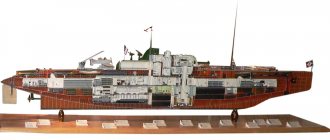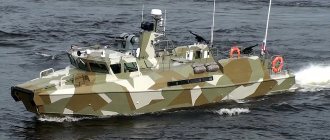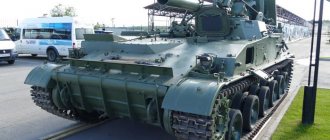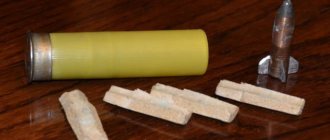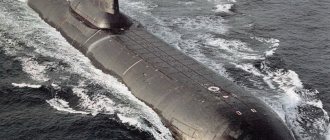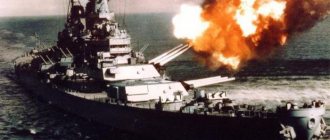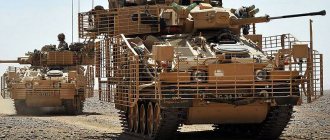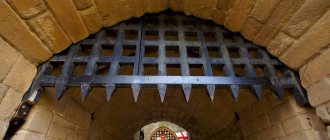The fifties of the last century were revolutionary in the development of nuclear weapons. After the atomic bombs were dropped on Japan, everyone became convinced of the power of this energy. Development of other types of nuclear weapons began - nuclear aircraft , nuclear tanks , nuclear carriers and even conventional cars with a nuclear engine . The attempt to use atomic energy everywhere has reached small-caliber weapons - pistols, machine guns, machine guns, and so on.
History of the development of nuclear-charged cartridges
Soviet scientists and military personnel decided to combine atomic bullets with one of the best and most popular weapons in the USSR - the Kalashnikov machine gun. Accordingly, we had to fit into its standard caliber – 7.62mm. A standard cartridge of this caliber usually weighs about 15-20 grams. It is known that uranium-235 and plutonium-239 have a critical mass of at least one kilogram. USSR nuclear scientists found a way out of this situation - the radioactive isotope californium-252. Its critical mass is only 1.8 grams, which would allow a powerful explosion with just one shot.
Despite this, the mass of the bullet still turned out to be heavier than the standard one, as a result it was necessary to increase the amount of gunpowder in the cartridge. It seemed that all the problems had been solved - get a weapons license and produce new weapons for the army. But you and I know that such bullets are not used now, but why?
Tests of nuclear cartridges that began in Semipalatinsk revealed several problems. When fired, up to 5 W of thermal energy was released, which could lead to the bullet getting stuck in the chamber or in the barrel. And to store ammunition, a special refrigeration unit was required, which created ideally safe conditions, namely a temperature of -15˚C. The technologies of the sixties of the last century in the USSR could not solve this problem. The “lightest” refrigerator for such cartridges had a mass of 110 kilograms and would cool nuclear bullets with liquid ammonia. And after removing the atomic bullet from the refrigeration unit, it had to be used within a maximum of half an hour. And the total shelf life of such weapons did not exceed several years due to the short lifespan of the isotope.
Getting California-252 was also a problem. Using nuclear reactors for this at military nuclear power plants, like the Siberian one was very expensive.
Dangerous bullets
Everyone was silent about this mysterious and secret development; some information about it slowly began to be revealed only after the collapse of the Soviet Union. One such bullet was quite enough to melt an entire tank, and not a simple one, but an armored one. To destroy an entire building several stories high, it was enough to fire just a few of these cartridges at it. But such a unique and dangerous development eventually had to be curtailed, and for good reason. But this is not the most surprising thing, but the fact that they really existed.
Atomic bullets were among the secret developments of the USSR
The creation of such bullets took place in the 1960s, when there was a confrontation between the USSR and an equally strong power - the USA. Both powers competed in military and space developments. The cartridges were created right then, and they even had time to test them. This was ammunition intended for heavy machine guns, its caliber was 12.7 and 14.3 mm. A bullet of an even smaller caliber was created later - 7.62 mm, which was intended for the Kalashnikov heavy machine gun.
What were these munitions made of - small and very dangerous? Atomic bombs were made using dangerous substances such as uranium and plutonium. But according to sources, USSR specialists used a completely different substance - californium. This substance has its advantages: low atomic weight and at the same time high critical mass, the formation of 5 to 8 neutrons during decay. Plutonium and uranium cannot boast of such an indicator.
An idea ahead of its time - 1960s
In the 60s of the 20th century, Soviet scientists began to think about how to reduce the size of the nuclear bomb while maintaining all its destructive potential. As part of their research, scientists tested many nuclear substances until they stumbled upon a special element, or rather, its isotope. More about it a little later.
Having discovered this substance, scientists dramatically changed their idea, moving from reducing the standard bomb to creating a fundamentally new weapon - the atomic bullet. After all, bombs already exist and everything for them has long been invented, but there are no small bullets that could burn through the thick armor of a tank or even destroy an entire building plus create atomic radiation on a much smaller area of land than a conventional atomic bomb does. In this way, it was possible to conduct military operations selectively, and not immediately destroy entire cities and regions. This method was more humane, and the capture of city after city could have happened faster here.
Information about an attempt to create a nuclear weapon that fits into the size of a machine gun bullet has recently reached us. Similar information began to leak out after the USSR collapsed and Semipalatinsk became the territory of Kazakhstan. But all this was not accurate and resembled fables. The real data was revealed only recently, after the Russian leadership began declassifying archival documents en masse. So what do we now know about atomic bullets, their filling, characteristics and range?
How were atomic weapons created in the USSR?
According to another version, the mechanisms were developed not in the USA, but specifically in the USSR, during the Cold War, when the state experienced an urgent need for serious firearms. The guns did not pose much of a threat, but their range of destruction remained consistently wide. The products began to be widely used for destruction in any radius. These bullets were not only distinguished by their high quality, but also by their long sighting range. Currently, the products are considered the most advanced weapons that hit the target accurately. Among the many types of atomic weapons, it was precisely such mechanisms that became the most discussed in the USSR.
The basis for the weapon was the complex chemical element californium. The discovery of californium made it possible not only to make the variant a serious and powerful weapon that hits a target, but also to open up new opportunities for universal hand-crafted development. Products of this brand were planned to be actively used in defense; before this, testing of new shells should have been carried out. Today, mechanisms are considered the most advanced type of weapon. When the basis for the striking projectile was invented, a new problem arose, namely the release of large doses of californium into the atmosphere. This huge release made the product too vulnerable. During storage, the now invented bullets began to emit a large amount of heat. This became the main problem in storing such shells.
A project without a future
Inside each projectile there was a tiny part that weighed only a few grams; this was the same Californian. But size is not an indicator here; one such bullet seemed capable of much, which was clearly proven by tests. When one such small shell melted an armored tank, the developers realized that they had created unique cartridges. But he had no future; after 20 years the project was completely closed, although it was not finalized. There were significant disadvantages: californium intensely released heat during decay, the shells became very hot.
Californian was used in the manufacture of such cartridges.
Because of this, a heated cartridge could get stuck in the chamber or barrel, but what is even more dangerous is that the charge could fire spontaneously. It is clear what terrible consequences the development called atomic bullets could lead to. The cartridges that had already been created were stored in a special “refrigerator”; it was a thick plate of copper with a coolant of liquid ammonia. In such a unit the temperature was -15 degrees. But the refrigerator was inconvenient to use and weighed more than 100 kg, requiring electrical energy. It would be very inconvenient to use such a unit on the battlefield.
And volleys of “atomic weapons” take you on your final journey
240mm “Tulip” mortar, designed to fire tactical nuclear ammunition.
In the tactical nuclear weapons race, the Soviet Union has always been catching up
US President Barack Obama submitted the START III Treaty to the Senate for ratification. However, senators from the Republican Party are trying to link the signed agreements with the issue of Russian tactical nuclear weapons (TNW). In this regard, it is appropriate to remember what tactical nuclear weapons are and how they appeared.
LIMITED IMPACT
On May 25, 1953, on the deserted French Plateau in Nevada, a huge 280-mm T-131 semi-stationary gun was tested, which in appearance resembled the guns of the First World War. A shot rang out, and 25 seconds later the desert was illuminated by a bright flash that eclipsed the sunlight. A moment later, a mushroom cloud began to rise into the sky. For the first time in human history, a nuclear weapon was fired.
280 mm T-131 gun
Why was it necessary to create a nuclear cannon when there was already a reliable source of delivery of nuclear weapons - strategic aviation?
Firstly, high-altitude strategic bombers are good for hitting stationary targets, for example, large cities, factories, and are much less effective when operating against mobile targets.
Let’s assume that the “flying fortress” that bombed Hiroshima, under the same conditions (drop height – 11 km, bomb explosion time – about 50 seconds after release), threw a “baby” with a power of 20 kt on a Soviet cruiser of Project 68bis, which was moving at full speed in the ocean . The commander abruptly changed course and in these 50 seconds covered about 870 m. According to the project, the 152-mm MK-5bis turrets were supposed to remain combat effective when a 1-megaton bomb exploded at a distance of 750 m. As they say, comments are unnecessary.
Well, the quadratic probable deviation (QPD), amounting to many tens of meters when dropping a bomb from a height of 11 km, makes it unlikely that a concrete pillbox or tower-based coastal battery will be hit. In all these cases, a direct hit from a nuclear weapon is needed.
The main thing is that after the tests of nuclear weapons in the USSR in August 1949, the US leadership realized the inevitability of a retaliatory nuclear strike on US cities. Already in the 1950s, the most sensible generals and politicians in the United States and England realized that a total nuclear war was pointless.
A characteristic glimpse of the new thinking was contained in the English Armaments Yearbook for 1952: “The possession of atomic weapons in two groups of states makes it probable that henceforth the war will be fought on a “cold” model, and if it becomes “hot” it will be in on a small scale, as, for example, was the case in Korea, Malaya and Indochina. Fear of atomic war, with its enormous destructive consequences, will very likely prevent another conflict like the wars of 1914-1918 and 1939-1945.”
As a result, from the beginning of the 1950s to the end of the 1980s, two doctrines of “limited nuclear war” were created in the United States. The essence of the first is the delivery of targeted strikes by strategic nuclear forces (ICBMs, cruise missiles, aircraft) on headquarters, missile launchers, airfields, naval bases, ballistic missile submarines at sea, etc. That is, delivering a pre-emptive strike capable of preventing a nuclear retaliatory strike. This doctrine is intended more for legislators and the public of the United States and NATO countries than for planning an actual war.
Another doctrine of limited war is much more interesting and realistic. This is a so-called local nuclear war, in which the use of nuclear weapons is limited both by the power of ammunition and by geographical boundaries.
The US government considered two options for waging a local nuclear war. This is a war in any particular third world country and a nuclear war in a theater of military operations. By “theater,” American strategists meant a large territory, such as Western and Central Europe, China, along with Indochina and Korea.
The initial carriers of tactical nuclear weapons (TNW) were to be jet fighter-bombers, including carrier-based aircraft, projectile aircraft (as cruise missiles were called until 1959), unguided tactical missiles and, finally, “atomic guns.”
The design of the 280-mm atomic gun M-65 (T-131) began in the USA in 1949. The first prototype was made in 1950. In the same year it was tested, put into service under the designation M-65 and put into mass production. Including the prototype, 20 M-65 guns were produced in the early 1950s.
The first nuclear projectile to enter service with the US Army was the 280-mm T-124 projectile. Its weight was 364.2 kg, and its length was 4.9 calibers. At maximum charge, the initial speed reached 628 m/s, and the range was 24 km. The minimum range was 15 km. The CEP of the projectile at the maximum range was 133 m. The T-124 projectile was equipped with a W-9 nuclear charge with a power of 15 kt.
The M-65 gun turned out to be inactive; it did not pass well through narrow streets and small bridges. The weight of the system in the stowed position is 75 tons. Formally, the gun moved from the stowed position to the combat position using hydraulic jacks in just 20 minutes, but in fact, taking into account the engineering preparation of the position, this took several hours.
The great and mighty 280mm M65 Atomic Annie.
The M-65 gun was delivered to Europe, where it was used to strengthen the US Army corps. It remained in service until 1963.
Subsequently, the Americans took into account the shortcomings of the first atomic gun. Their physicists were able to create in 1957 a nuclear warhead that could fit into a 203-mm projectile, and in 1963 - into a 155-mm projectile. Looking ahead, I will say that, at least until the end of the twentieth century, American and our physicists were never able to create a nuclear warhead that could fit into a projectile of less than 152 mm caliber.
So, in January 1957, the 203-mm M-422 artillery shell with the W-33 nuclear charge was put into mass production. The power of various modifications ranged from 5 to 40 kt.
Now let's move on to the most popular American caliber of nuclear weapons - 155-mm shells. In 1963, the 155-mm M-454 projectile, equipped with a W-48 nuclear warhead, was adopted. Projectile weight 58 kg, power 0.1 kt.
Naturally, the American fleet decided to acquire its own artillery shell. In 1953, work began on the creation of a 406-mm M-23 Katie projectile, equipped with a W-23 charge with a power of 20 kt. In 1956, the Katie projectile entered service with battleships.
ROCKETS GET PRIORITY
The first American tactical missile to carry a nuclear charge was the Onest John M-31 unguided solid-propellant missile.
Design of the Onest John rocket began in the late 1940s. Flight testing began in August 1951 at the White Sands Army Proving Ground in New Mexico. In 1953, the missile was put into service. The firing range of the first samples ranged from 9 to 27.5 km. At the end of the 1960s, the firing range of the Onest John missile was increased to 37 km.
In addition to the United States, Onest John missiles were used by the armies of Belgium, France, Holland, Taiwan, Great Britain, Denmark, Greece, South Korea, Turkey and Japan. Moreover, in Japan and South Korea, Onest John missiles were in mass production.
In 1956, the United States began developing the Little John solid-fuel unguided rocket. In 1961 it was put into service. The smaller weight and dimensions of the Little John missile and its towed launcher allowed transportation by N-34 helicopters and airplanes.
The first tactical guided missile of the US Army was the M4E2 Lacrosse radio-controlled missile, renamed MGM-18A in June 1963.
Design of the rocket began in 1948. The main developers and suppliers are Martan Marietta.
The launch weight of the rocket is 1040-1070 kg, length - 5840 mm, diameter - 520 mm, wingspan - 2.75 m, tail span - 1.45 m. The Lacrosse missile was an intermediate stage between ballistic and cruise missiles.
The weight of the warhead is from 181 kg to 244 kg. The missile was equipped with a W-40 nuclear warhead with a yield of 10 kt, produced from September 1959 to May 1962. A total of 400 nuclear warheads for the LaCrosse missile were produced.
The Lacrosse rocket is equipped with a solid-fuel dual-mode engine. Firing range – from 8 to 32–34 km. The missile was transported and launched from a combat vehicle built on the chassis of a three-axle army truck.
Testing of the LaCrosse rocket took place at the White Sands test site since August 1954. From August 1957 to 1960 inclusive, its mass production was carried out.
In 1962, research work began on the creation of the Lance guided missile. The system was adopted for service in 1972. The firing range with the XM234 nuclear warhead was 110–120 km.
Immediately after it was put into service, the delivery of the Lance missile system to NATO partners and Israel began. Already in the mid-1950s, the US government concluded a series of secret agreements with its NATO partners, according to which, during the “period of threat,” nuclear warheads stockpiled in Europe were to be transferred to the allies.
In the armies of the United States and other NATO countries, missiles and guns that carry nuclear warheads are included in divisions and corps. The exception was Italy, which formed a special missile-howitzer brigade, which was supposed to receive American nuclear warheads during the “threatened period.” In the 1960s, it included four divisions of Onest John missiles and two divisions of 203.3 mm howitzers.
GUNS WITH ROMANTIC NAMES
In the USSR, carriers of tactical nuclear warheads were initially created on the principle of mirror image with the United States. As a result, in the mid-50s, the following were submitted for testing: a 406-mm SM-54 (A-3) cannon, firing a special “Cadenser” shot (by the way, the entire system was often named after it, the weight of the projectile was 570 kg, the maximum firing range - 25.6 km); 420-mm smoothbore mortar 2B-2 "Oka", firing a special shot "Transformer" and 406-mm recoilless rifle S-103 (product 0842). All three systems were installed on a chassis created at the Kirov plant based on a heavy tractor.
406 mm self-propelled gun SM-54
2B1 "Oka" - Soviet 420 mm mortar
All three monsters turned out to be non-transportable and did not enter service. For half a century, prototypes of the SM-54 and 2B-2 have been exhibited in the courtyards of the Central Museum of the Armed Forces and the Artillery Museum. Children climb on them, but both systems are still considered secret.
The USSR was 15 years behind the United States in the creation of small-caliber nuclear weapons for conventional weapons. Only in 1964 did the design of the 240-mm 3BV4 mine begin in conventional (firing range - 9.5 km) and active-reactive (18 km) versions for 240-mm mortars - towed M-240 and self-propelled "Tulip"; 203-mm 3BV2 projectile for the 203-mm B-4M howitzer (18 km) and 152-mm 3BV3 projectile for 152-mm howitzers - towed D-20 and self-propelled "Akatsiya" (17.4 km).
Self-propelled 152-mm howitzer 2S3 "Akatsiya"
In addition, a 180-mm shot with 3BV-1 special ammunition was being developed for the 180-mm S-23 cannon and 180-mm ship and coastal installations. According to unofficial information received from naval officers, the cruiser “Slava” (nine 180-mm guns) was in the Mediterranean Sea during the “Six-Day War” of 1967, having combat-ready special ammunition.
Finally, special ammunition was designed for the 320-mm guns of the battleship Novorossiysk and 305-mm coastal batteries on Russky Island and near Sevastopol.
In the late 1950s and early 1960s, the USSR produced several dozen 3R-1 Mars and 3R-2 Filin tactical solid-propellant missiles. However, the Luna missile became a mass carrier of a tactical nuclear charge - a worthy answer to Onest John.
Tactical missile system 2K4 "Filin"
In response to the adoption of the Matador and Mace missile aircraft into service in the United States, the USSR created the FKR-1 (KS-7) and FKR-2 (S-5) cruise missiles, based on the KS-1 aircraft missile. Comet" and the P-5 boat rocket. OKB-52's attempt to create a "Soviet Lacrosse" - the Malyutka complex - failed.
In the 1960s, almost all types of aviation, army, anti-aircraft and naval guided missiles began to be equipped with special charges. The main thing is that the diameter of the warhead should be no less than 150 mm, and the weight should not exceed 25 kg.
It should be noted that in both the USA and the USSR, tactical nuclear weapons did not fall below the divisional level. The only type of close-combat nuclear weapon adopted for service in the United States was the Davy Crocket system. This system included two smooth-bore recoilless guns M-28 and M-29 with a caliber of 120 mm and 155 mm, created according to the “widened” design. chamber".
The first Soviet tactical atomic bomb, developed in 1953.
Both guns fired the same M-388 over-caliber projectile with a W-54 Y1 nuclear charge. The charge power, according to various sources, ranged from 0.05 to 1 kt. From 1961 to 1971, over 2,100 W-54 Y-1 nuclear warheads were manufactured for the Davy Crocket system.
Both systems were disassembled. The light M-28 system was carried on the battlefield by three crews in packs weighing about 18 kg. Both systems were fired from a tripod and from a jeep.
In 1962, Davy Crocket guns were deployed to Western Europe. They were armed with infantry divisions (20 launchers each) and airborne battalions.
In 1959, the development of close-combat nuclear shells for tank divisions and regiments began. The projectile was named "Shilleila" and indexed MGM-51. The carrier of the Shilleila was to be the M511 Sheridan light tank. The firing range of the Shilleila with a nuclear warhead is 4–5 km.
In response to Davy Crocket, the USSR developed the Reseda complex. Only our recoilless rifle fired 9M-24 over-caliber active-rocket projectiles not from a jeep, but from an BTR-60PA. Firing range 6 km. According to the plan, the Reseda complex was supposed to be submitted for State testing in the second quarter of 1965.
In 1968, the design of the Taran and Rosehip tactical missile systems with special warheads began. The Taran complex was intended for tank regiments, and the Rosehip complex was intended for motorized rifle regiments. According to tactical and technical requirements, the maximum firing range should have been 6–8 km, and the minimum – 1–2 km.
The launcher of the Taran complex was located on the tank - initially on the “287 object”, then on the T-64A. As in the case of the Shilleila, an ATGM was created on the basis of the Taran for tank self-defense. The launcher of the Rosehip complex is located on the BMP-1.
But neither “Shilleyla” nor “Taran” with “Rosehip” entered service with tank, motorized rifle and motorized infantry regiments. It can be assumed that somewhere in the early 1970s, the USSR and the USA secretly agreed not to equip regiments and battalions with special ammunition.
DUBIOUS PROSPECTS
The United States has planned to use tactical nuclear weapons several times. The first time was in Korea in 1950–1953.
In early 1954, French troops fighting in Vietnam found themselves in a stalemate in the Dien Bien Phu area. The American Air Force was ready to drop nuclear bombs on the positions of the Vietnamese troops, but at the last moment Washington canceled the order.
The details of the US attack plan on Cuba in the fall of 1962, as well as the plans of the Soviet command for the defense of Liberty Island, are still kept secret. But, apparently, both sides were ready for both total and local nuclear war in the Caribbean.
It is curious that 12 American Onest John missiles with nuclear warheads in the invasion forces were opposed by 12 Soviet Luns with warheads of 2 kt each. In addition, the following tactical ammunition was brought to Cuba: for FKR-1 cruise missiles - 80 warheads with a capacity of 2 to 20 kt; for Il-28 bombers - six 407N aerial bombs of 8–12 kt each; to the Sopka coastal complex - six combat units and three sea mines.
At the end of the 20th – beginning of the 21st century, when committing aggression against sovereign states, such as Iraq, the Pentagon threatened to use tactical nuclear weapons if chemical or bacteriological weapons were used against the invading forces.
In 1991, even before the collapse of the Soviet Union, the Ministry of Defense removed all tactical nuclear weapons from the territories of the union republics. Well, then politicians and the media completely forgot about tactical nuclear weapons in Russia.
Everyone can easily check that 95% of the information about land-based tactical nuclear weapons in Internet search engines is taken from my book “Atomic Ram of the 20th Century,” published by the Veche publishing house in 2005.
And only at the beginning of 2010 the topic of tactical nuclear weapons again became discussed. Naturally, the Americans were the first to start the conversation. In early January 2010, during Senate hearings on the Pentagon budget for the 2011 fiscal year, the head of the Joint Chiefs of Staff, Admiral Mike Mullen, announced Washington’s intention to begin negotiations on the reduction of tactical nuclear weapons immediately after the signing of the Strategic Arms Reduction Treaty.
The admiral confirmed that Russia had already raised the issue of tactical nuclear weapons during the START negotiations, but Moscow considers its discussion in the context of work on START “informal.” Officially, Russia is not against starting negotiations on tactical nuclear weapons, but calls the withdrawal of American tactical missiles from the territory of Western Europe a precondition for this.
Russian Foreign Minister Sergei Lavrov spoke about this at the beginning of February at a meeting with his Norwegian colleague Jonas Gahr Stere. According to the minister, “Russia has been calling for many years to take the first step, namely, to remove all tactical weapons from the territory of the states to which they belong,” but it still cannot “reach out to its partners.”
The Western media are circulating data that the United States has significantly fewer tactical nuclear warheads than Russia. The United States supposedly has 1,200 of them, 500 of which are in a state of combat readiness. 200 of the latter are located in Europe. Russia, according to unofficial data, and there were no others, has 5,400 such warheads, two thousand of which are in a state of combat readiness.
Now the Obama administration plans to conclude an agreement with the Russian Federation to limit the number of tactical nuclear weapons. Apparently, we are talking about bringing them to an equal number for both powers. At the same time, the United States is clearly not going to take into account the nuclear warheads of England, France, Israel and China. Let me note that, according to Western media, Israel has over 200 tactical nuclear warheads ready for immediate use.
Moreover, the United States is trying to bring Russian tactical nuclear weapons under its control. In the future, the Russian Federation and the United States will have to store all tactical nuclear weapons in places specified by the treaty.
Is this beneficial for Russia? Let's follow Admiral Nelson's favorite saying: “Know how to count!” Let's start with the fact that the United States is now superior to the Russian Federation in tactical conventional strike weapons by an order of magnitude, or even two.
For example, an F-16 fighter-bomber with a bomb load of about 2 tons has a combat radius of over 2,500 km. From NATO air bases in the Baltics, he can bomb not only Moscow, but also Kazan, and from bases in Turkey - Saratov and Samara, from bases in Central Asia - Chelyabinsk and Novosibirsk, from bases in Japan - Vladivostok, Khabarovsk and Petropavlovsk-Kamchatsky. But the F-16 is considered a tactical aircraft. In addition to the United States, it is in service with most NATO countries and Israel.
Most of the territory of the Russian Federation is in the zone of destruction of Tomahawk cruise missiles, which are armed with American nuclear submarines and approximately eighty cruisers and destroyers. Finally, the US Navy operates 12–13 aircraft carriers, of which 11 are nuclear-powered. Each aircraft carrier is home to 70 to 90 aircraft, including F-14 and F/A-18 fighter-bombers, electronic warfare aircraft, and tanker aircraft. Using mid-air refueling, the F/A-18 can hit targets at a distance of 3-4 thousand km.
In turn, not a single Russian tactical aircraft can reach US territory, not counting Alaska.
In such a situation, only tactical nuclear weapons can somehow even the odds. Moreover, the possibility of a retaliatory strike using tactical nuclear weapons deters both large and small aggressors. And the position of the United States and the Russian Federation is incomparable in military-political and geographical terms.
Only a combination of strategic and tactical nuclear weapons can guarantee the security of the Russian Federation. The storage of tactical nuclear weapons will lead to the unilateral disarmament of Russia. But negotiations on reducing the number of tactical nuclear warheads and their storage are absolutely necessary. At the same time, they should no less necessarily be linked with other problems - Russia’s free access to the ocean, an extraterritorial transit corridor (with highways and railways) to the Kaliningrad region, Japan’s renunciation of territorial claims, and many others.
Still, no: the USSR stopped the development of the project
You probably noticed that the word “special” appears often in the text, since everything, from the smallest details to standard things, had to be adjusted to the recommended use of the atomic bullet. Otherwise there was a risk of self-detonation. Individual transport, a refrigerator, equipment for eliminating overexposed shells - all this required large investments, and the return, in the opinion of the country's leadership, was minimal.
The leadership of the USSR did not find it expedient to produce such cartridges, not only because they would be too expensive to maintain and create, but also because the energy emitted by California always varied from 100 to 700 kg in equivalent spent. Thus, it was difficult to predict how the projectile would explode and whether the shooter himself would receive a dose of radiation. Even a sniper rifle did not guarantee safety.
Igla MANPADS
However, this did not mean that the very idea of small nuclear weapons was bad. It’s just that at that time there was neither the strength, nor the money, nor the vital necessity to finalize the brilliant idea. The country was already armed with the Strela and Igla anti-aircraft missile systems, which were no less expensive to produce and operate, but more multifunctional. And there were enough simple bombs and shells to destroy any armored or living target without the risk of getting hurt yourself.
It is unknown whether modern development of nuclear cartridges is underway in Russia. Although, given the latest super-efficient Russian developments (the Avangard supersonic missile, the Peresvet laser complex, the Burevestnik cruise missile, the Poseidon unmanned submarine and the Kinzhal anti-ship missile), we will not be surprised if scientists pull out a forgotten one from the dusty archives Project "Atomic Bullets".

